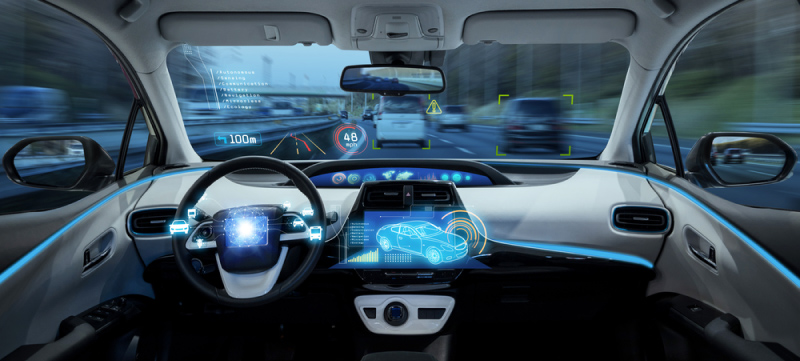Introduction and Background
The automotive industry is undergoing major change through its incorporation of automotive Internet of Things (IoT) devices. This accompanies a paradigm shift driven by the increasing demand for electric vehicles, autonomous vehicles, and shared mobility. IoT-powered smart cars can already monitor driving behavior and provide real-time feedback, alerting drivers of potential dangers such as speeding or distracted driving. In this way, automotive IoT technology can reduce accidents and save lives.
A further key benefit of IoT in the automotive industry is that automakers can optimize supply chain and manufacturing processes for improved speed, efficiency, and environmental footprint. Using automotive IoT technology, distributed sensors can monitor production lines and relay that information to the cloud or edge computing systems. Automakers can use this data to identify and eliminate inefficiencies in real time, reducing downtime and increasing productivity.
According to Statista, the global market for IoT technology was worth around $621.6 billion in 2020, and it should grow to approximately $1.1 trillion by 2024 at an approximate compound annual growth rate (CAGR) of 13%. The market value for connected cars and IoT is also expected to climb to $42 billion by 2024 from $27 billion in 2020, with a CAGR of 9.2%. At the same time, the global automotive IoT market has reached a value of $144.42 billion in 2023, with a predicted value of $219.61 billion by 2026.
What’s clear is that IoT is the future, and automotive IoT is changing the development trajectory of the entire concept of human mobility.
Autonomous Vehicles
The market for autonomous cars also looks likely to grow in the coming years, with IoT playing a critical role in developing and deploying these vehicles. IoT-powered autonomous cars can communicate wirelessly with other vehicles, transportation infrastructure, and even pedestrians. This communication can enhance safety and lead to more efficient road use, decreasing traffic congestion and travel time.
Although the COVID-19 pandemic in 2020 brought many AV trials to a temporary halt, many have since resumed. However, like the shared mobility situation, it has become gradually clear that there may still be a long road to a world where AVs are available at a significant scale.
Shared Mobility
The impact of shared mobility on the automotive industry has threatened significant disruption for years without actually leading to a mass exodus from traditional car ownership thus far. Early predictions implied that conventional vehicle ownership models would be swept aside by new options for travelers in densely populated urban settings. However, many such offerings have come and gone, from micro-mobility (like scooters) to full OEM-supported vehicle-sharing players (like BMW’s DriveNow). Of course, the impact of AI and autonomous vehicles may combine with IoT app development and automotive IoT to drive much more significant change in this area in the coming years.
Automotive Batteries
Unsurprisingly, the demand for automotive batteries is increasing in lockstep with the increase in demand for electric vehicles. Since batteries are a key input cost and primary limiting factor on the overall cost of ownership, the EV market’s long-term success hinges on developing even more efficient and cost-effective batteries. As a result, many companies are investing in the research and development of entirely new battery technologies to meet this demand.
According to Global Data, the global demand for battery electric vehicles (BEVs) will approach 11 million units in 2023, with 12.5% of Light Vehicle (LV) sales globally in 2023 being a BEV, while the total electrified market will exceed 30% of demand. In North America, BEV sales will break the 1 million units level in 2023 with 1.3 million EVs delivered. Therefore, share-wise, BEVs are likely to exceed 7% of the North American LV market in 2023.
Electric Vehicles (EVs)
The increasing demand for electric vehicles (including hybrids) is a significant trend in the automotive industry, driven by concerns over climate change and environmental sustainability. As a result, many automakers are investing in the development of electric vehicles, and the technology is likely to become more widespread in the coming years.
According to the International Energy Agency, electric vehicle (EV) sales doubled from 2020-21 to a record total of 6.6 million or just under 10% of the global total of car sales. Even more stunning, these numbers reflect a quadrupling of the market share of EVs in 2019. With these increased sales numbers, the total global number of electric cars fully tripled from 2018 to reach a total of around 16.5 million. This strong rise in global sales has kept pace, coming into the first quarter of 2022 with a 75% rise from the prior year up to 2 million cars. These trends show no signs of slowing down, with demand for electric vehicles now vastly outstripping supply as manufacturers rush to build additional capacity and utility providers prepare for the mass electrification of transportation.
Automotive IoT Case Study
One of the most intriguing areas of the emerging electric vehicle market is the convergence of home entertainment technologies with automotive IoT in the form of in-car automotive multimedia systems that would be the envy of the neighborhood just a few years ago. These display and multimedia units are the vehicle’s primary human-machine interface (HMI), and they can double as a fully-fledged computer, video gaming console, or entertainment unit.
Here is one example of such an in-car multimedia system. For this project, Softeq, a US-based global digital transformation company with a focus on IoT, needed to design and build a multimedia unit for a client’s electric vehicle. This multimedia unit needed to serve as an HMI, an entertainment console, and a primary data display in case of any emergency. The ultimate solution interfaces with multiple displays and supports Wi-Fi, LTE, and Bluetooth connectivity, numerous radio standards, and noise cancellation. In addition, the unit allows for the development of new apps for the vehicle after release, and it is also pre-certified to the ISO 26262 automotive industry standard defining functional safety for automotive equipment.
This project demonstrates the need for an experienced tech partner in automotive IoT with the capacity to create end-to-end solutions and go from concept to market-ready product. Softeq is an ideal partner for startups and conventional automakers because of its significant expertise in hardware prototyping and its ability to design complex solutions like Advanced Driver Assistance Systems (ADAS) from concept to market-readiness. As a global leader in automotive IoT with wide experience in hardware, software, and manufacturing partnerships, Softeq is an ideal partner for innovative design projects in emerging as well as conventional automotive technology.
Conclusion
IoT in the automotive industry is already showing its potential to revolutionize the manufacturing, repair, and driving experience by facilitating the development of smart and connected cars that are safer, more efficient, and even more enjoyable to drive. As demand continues to grow for new categories of vehicles that are even better suited to automotive IoT, such as electric vehicles, autonomous vehicles, and shared mobility, automotive IoT will certainly play an increasingly critical role in the automotive industry’s future.
The post Driving the Future: How IoT is Transforming the Automotive Sector appeared first on IoT Business News.



























